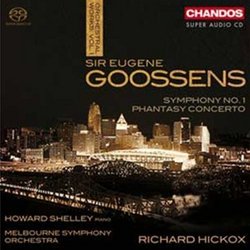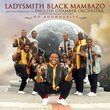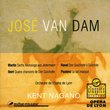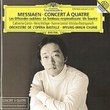| All Artists: Shelley, Melbourne Symphony Orchestra Title: Goossens: Symphony No. 1; Phantasy Concerto Members Wishing: 0 Total Copies: 0 Label: CHANDOS CHACONNE Original Release Date: 1/1/2009 Re-Release Date: 2/24/2009 Album Type: Hybrid SACD - DSD Genre: Classical Styles: Forms & Genres, Concertos, Symphonies Number of Discs: 1 SwapaCD Credits: 1 UPC: 095115506820 |
Search - Shelley, Melbourne Symphony Orchestra :: Goossens: Symphony No. 1; Phantasy Concerto
 | Shelley, Melbourne Symphony Orchestra Goossens: Symphony No. 1; Phantasy Concerto Genre: Classical Chandos Featured release for February will be the final recording made by Richard Hickox. Intended as the first in a cycle of orchestral works by Goossens this disc offers the premiere recording of Phantasy Concerto for Pi... more » |
Larger Image |
CD DetailsSynopsis
Product Description Chandos Featured release for February will be the final recording made by Richard Hickox. Intended as the first in a cycle of orchestral works by Goossens this disc offers the premiere recording of Phantasy Concerto for Piano and Orchestra, and the rarely recorded Symphony No.1 and serves as a tribute to Hickox and his fantastic legacy of recordings on Chandos. Though principally remembered as a conductor, during the 1920s British composer Eugene Goossens was a prolific composer, regarded as one of the foremost British composers alongside Bax, Bridge and Walton. Sadly his music has been all but forgotten for the colourful, expressive nature of his music fell out of fashion on the 1950s and 1960s. A recent reviewer of Goossens' music wrote, If you have ever gleaned the idea that Goossens is inclined to grey modernism or to windy rhetoric, prepare to have your preconceptions well and truly shattered. His music is suggestive of fellow composers of the era, namely Holst and Bliss. Having grown up in Britain, Goossens accepted an invitation to come to the United States as the first chief conductor of the Eastman-Rochester Orchestra in New York State. He was there for twenty years, before moving to Australia serving as Chief Conductor of the Sydney Symphony Orchestra. His music and character proved a great influence on the Australia classical audience; in fact he is recognised as one of the most noted figures in Australia music in recent years. The rewarding Phantasy Concerto, Op. 60 for Piano and Orchestra was written for the celebrated Spanish pianist José Iturbi who gave its first performance in 1944. The work, particularly the slow movement was influenced by my re-reading at that time of Edgar Allan Poe's The Devil in the Belfry, and might be said to reflect something of the fantastic and sinister character of that story, though in no way being a literal depiction of it, wrote Goossens. The concerto was the outcome of a discussion between Iturbi and the composer over the lack of new piano concertos and especially on a smaller scale. The result is a four movement piano concerto in compressed sonata form. The solo part is more of a concertante than a display concerto, with a tendency to make the solo part an integral part of the orchestral texture. Goossens used the word conversational to describe this relationship between soloist and orchestra. This premiere recording is coupled with the melodic and imaginative Symphony No.1. Similarly Requested CDs
|
CD ReviewsA very rewarding album of the music of a very adventurous, b David A. Hollingsworth | Washington, DC USA | 09/30/2009 (5 out of 5 stars) "Who could have known (or even realized) that Sir Eugene Goossens' fame as a conductor would have possibly hinted his career as a composer of considerable stature (during his life and long afterwards)? I for one didn't (I shall confess). But luckily, I came across Dutton's reissue of Goossens' powerful recording of Bax's Second Symphony (which also includes, among other things, the conductor's "Tam O'Shanter" and Antill's "Corroboree" excerpts). I decided to investigate Goossens' music further and discovered a wonderful, explorative 3-disc ABC album of some of his major works (like the two symphonies, the Oboe Concerto, and even his earlier Variations on a Chinese Theme) ebulliently yet movingly performed by the late Vernon Handley and the major Australian orchestras. Immediately I was blown away and knocked over by the solidity, the beauty, and the unrelenting senses of adventurism and imagination page after page, passage after passage. And while Goossens was not terribly prolific and not quite in the same league as Bax, Vaughan-Williams, or even Walton, he undoubtedly poses serious challenges to the qualities and communicative impacts of their own music. Needless to say, this legendary conductor yet relatively obscured composer is indeed a force to be reckoned with.
A case in point here is Goossens' First Symphony. And allow me to state straight away that this work measures up to even the strongest symphonies of Bax and Vaughan-Williams in its melodic invention and its sheer strength in concentration of musical thought. This composer clearly knew how to work the ideas and to the point: no wandering, no padding, but straightforward yet ingenious and resourceful. Written in 1938-40 and dedicated 'To my Colleagues of the Cincinnati Symphony Orchestra', this symphony is a very cogent piece, yet with that arresting inner beauty, subtlety, and passion especially in the slow movement that I find literally inescapable. In those regards, it indeed puts to mind Bainton's Third Symphony (1956) and it has become somewhat a tradition of mine in playing these two works together (and come to think of it, both Goossens and Bainton were composition students of Sir Charles Villiers Stanford at the Royal College of Music in London). Here, Hickox's structural control of the symphony is tighter than Handley's. He wastes virtually no time in getting the points of the faster movements across (the finale in particular goes off with thrust and utter commitment). Needless to say, his read is indeed exciting. But there is something more of that organic coherency and integration in Handley's take that I find captivating and unforgettable. The andante movement is an example of this, where Handley's conception has more of that arresting nuance and heart wrenchingness than Hickox's (which is a shade faster). To Chandos' credit, its recording sound is more realistic than ABC's (listen to the depth of the bass clarinet solo that begins the slow movement). But at the end of the day, I am hard pressed to find myself without both recordings of this remarkably assured musical creation. Another case in point is Goossens' Phantasy Concerto for Piano and Orchestra (1942), which I likewise deem as remarkable in that sense of adventure and imagination so much identifiable with this composer. Written for the celebrated Spanish pianist José Iturbi (who first performed it on February 25th, 1944 with the Cincinnati Symphony Orchestra with Goossens at the podium), it is in four continuous, unconventional movements (with many tempo markings by the way). The piano writing is especially alluring yet complimentary (conversational as the composer described it) and the orchestral support mesmerizing (Rachmaninov looms a bit noticeably here, with pinches of Hanson, Vaughan-Williams, Barber, Ravel, Poulenc and Bax thrown into the mix). Yet like Ginastera's Harp Concerto (which Hickox also recorded with Chandos), Goossens' work is, on its own terms, flamboyant, spicy, and not so superficial. And unsurprisingly, and yet with upmost delight, pianist Howard Shelley remains unflinched by the verve and the flamboyancy the piece requires. But his sense of poetics and invention never fails him either (particularly in the slow movement), with Hickox and the Melbourne Symphony responding with zest and wholehearted embellishment. The recording and overall presentation are again first class: and special thanks are to due to Lewis Foreman for his revelatory sleeve note (as always). This album is dedicated to the memory of Richard Hickox who passed-on all too soon last November. It is indeed a special album, not only because of this dedication, but also because of its enduring testament of the musical virtues and artistry the great conductor espoused time after time again during his tragically short career. Thus, many thanks to Chandos for that ever so extraordinary, enterprising release (again as always, of course). " |





